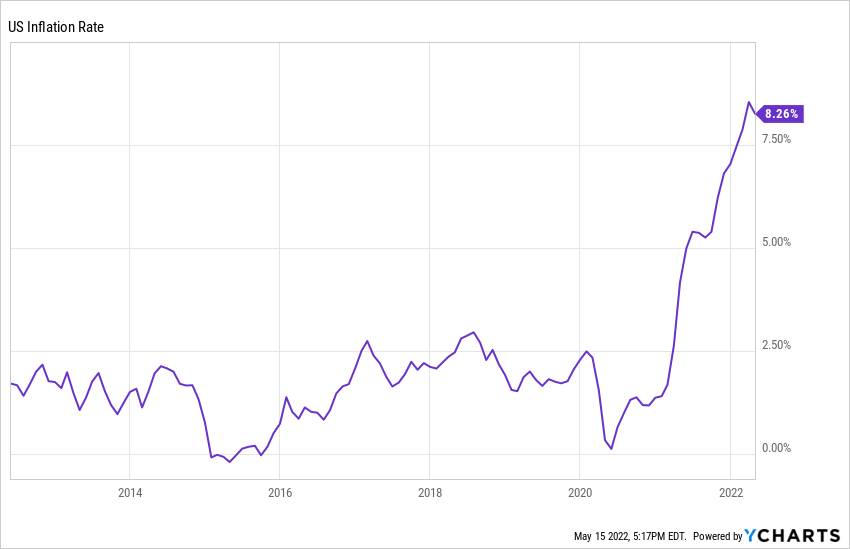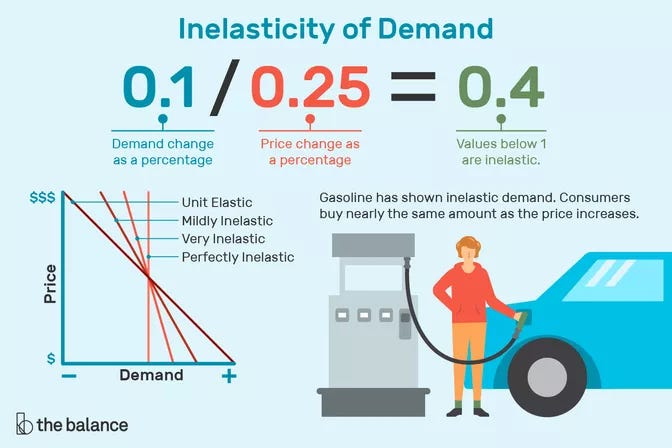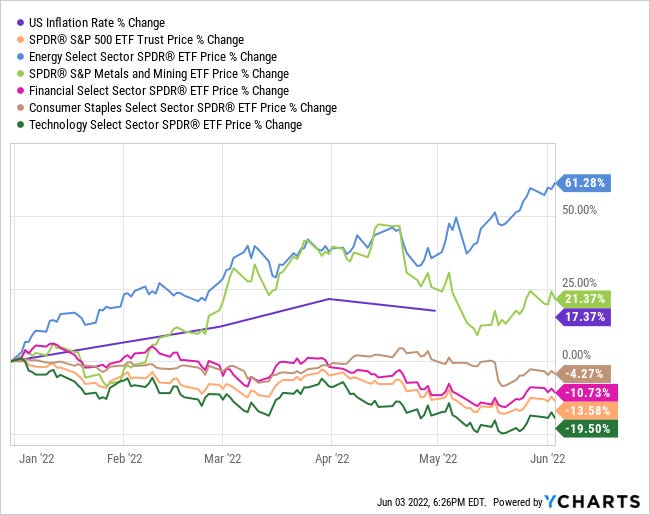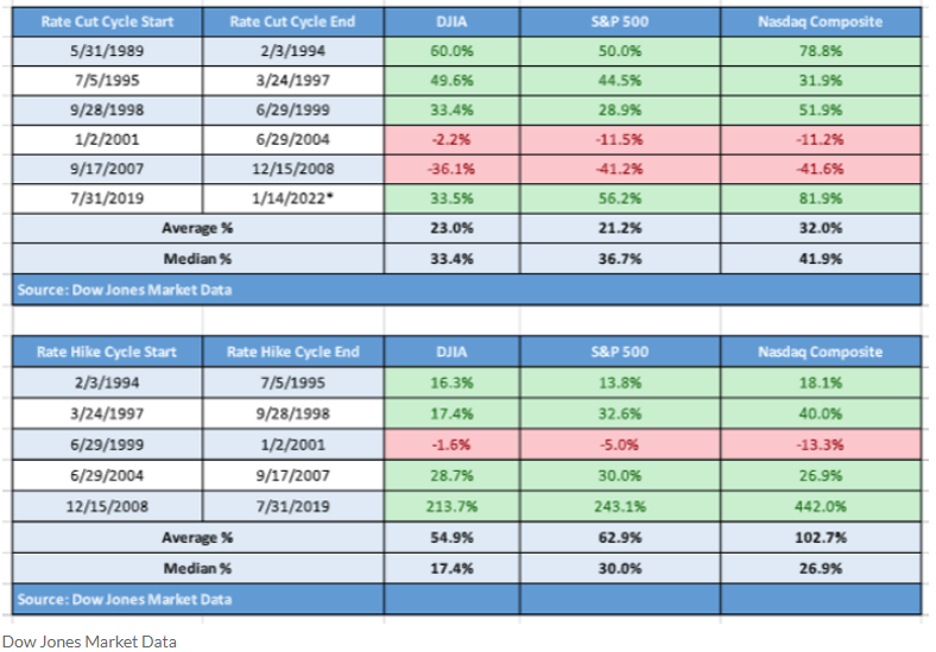Nobody likes cost of living going up and purchasing power going down. In April inflation hit a 40-year high of 8.5%, followed by an 8.3% reading in May. The war in Ukraine has exacerbated a challenged supply chain across the world and it’s evident across the economy. As we brace for June’s reading on the 10th, this level of inflation puts more pressure on the question: what are you doing with your money? This post will cover…
How inflation is measured
Causes of inflation
How the government handles inflation
Assets that do well when inflation is high

How Inflation Is Measured
The two leading inflation metrics are the Consumer Price Index (CPI) and the Personal Consumption Expenditure (PCE) price index. CPI is measured by the Bureau of Labor Statistics (BLS) through a survey of ~24,000+ consumers every quarter covering the prices of ~80,000 items. PCE is measured by the Bureau of Economic Analysis (BEA) and pulls data from the companies that sell the products instead. I’ll focus on CPI since it’s most commonly used. It can be reported as the month-over-month price increase, but it most commonly refers to year-over-year (like the chart above).
CPI Weighting
Housing- 42%
Transportation- 18%
Food and Beverages- 14%
Healthcare 8%
Education and Communication-6%
Recreation- 5%
Other Goods and Services- 3%
Apparel- 2%
Who is Surveyed in the CPI?
The CPI statistics cover professionals, self-employed and unemployed people, people whose incomes are below the federal poverty threshold, and retired people. People not included in the report are non-metro or rural populations, farm families, armed forces, people currently incarcerated, and those in mental hospitals. -Investopedia
Causes of Inflation
There are two things that influence price: supply and demand. Prices go up when either supply goes down or demand goes up. Or both. If you commit one thing to memory regarding economics, it should be the concept of supply and demand.
“Teach a parrot the terms ‘supply and demand’ and you’ve got an economist.” -Thomas Carlyle, Scottish essayist, historian and philosopher in the 1800s
Law of Supply and Demand
The law of demand says that at higher prices, buyers will demand less of an economic good.
The law of supply says that at higher prices, sellers will supply more of an economic good.
The best way to visualize this is through a supply and demand curve. See the example below and let’s pretend that the item is a laptop.
Different Types of Demand
It’s worth noting that there are different types of demand. The term elasticity of demand refers to how sensitive demand for a good is compared to changes in other economic factors, such as price or income. The blue “demand line” above represents elastic demand. Things like electronics, airline tickets, and clothing are example of things people want less of as price goes up. Examples of things that have inelastic demand are gasoline, your utilities, and luxury products. Lack of a substitute is a common attribute of inelastic demand. For luxury products, they are already intentionally priced out of the demand zone for most consumers and are naturally less sensitive to price. It doesn’t mean that demand isn’t affected by price (unless it’s perfectly inelastic) as the extent of the (in)elasticity is different for every good or service.

Current Example: Gas Prices
Let’s look at an example of why supply and demand shifts. If you’re like me you’ve felt assaulted leaving the gas station recently. The price of oil influences 59% of the price of gasoline. Here are several factors that have driven the 76% increase in the price of gas since January 2020.
The US is currently producing 1.4 million (11%) barrels of oil less per day than February 2020. Effect: supply going down
Russia supplies 10% of the global supply of oil. In March the U.S. government banned all Russian oil imports as part of a package of economic sanctions to punish then for invading Ukraine. Oil and natural gas exports are a huge revenue source for Russia and accounts for ~36% of the country’s total budget. Effect: supply going down
There are other factors limiting supply. The oil and gas industry is no exception to labor shortages and supply chain challenges (trucks, rigs, other input costs). It’s not as simple as just “drilling more.” As a matter of fact, there are over 9,000 unused federal permits (for drilling) currently. Also, it’s the era of fiscal discipline in the industry. Over-producing caused the price of oil, and the ensuing stock prices, to crash in 2014. The industry severely under-performed the rest of the stock market for several years until 2021. Social, environmental, and governmental pressure against fossil fuels has been mounting over the years as another factor. All in all, these companies have little incentive to pursue aggressive growth.
The pandemic concluding obviously has caused an explosion in travel. Effect: demand going up
The output of it all… a 76% increase in gas prices since January 2020.
How The Government Handles Inflation
I’ll start by saying that inflation is not automatically bad. The Federal Reserve actually wants ~2% inflation. Why? Well, prices go up when demand is greater than supply. Moderate inflation is a good signal that the U.S. economy is growing. Let’s take a step back though. The Federal Reserve System is the central bank of the United States. Their job is referred to as the “dual mandate” and is simply:
Promote maximum employment
Stable prices
What Does “The Fed” Actually Do?
Well, a few different things. I’m going to focus on their role moderating interest rates. You’ve probably heard “The Fed is raising rates” and those rates are referring to the federal funds rate. This rate is one of the most significant leading economic indicators in the world. Functionally, it determines the interest rates banks charge one another for overnight loans. The Federal Open Market Committee (FOMC) meets eight times per year to discuss conditions and make decisions. The discount rate functions similarly (and they are often the same) except it’s the rate the Fed charges banks as a lender of “last resort.” Higher rates slow down economic activity (effect: demand goes down) and have a dampening effect on price, thus, combatting inflation. This effect goes the opposite way and when things are bad, like the pandemic-induced recession, rates will often get cut to zero. These rates are also the benchmark for many other rates across the economy.
What Can Complicate This Effort
We know that supply going down and demand going up causes price to rise. We know that the Fed raises rates to reduce demand. We know that inflation is based on prices rising across all planes of the economy. What we don’t always know is the extent of which factor (limited supply or high demand) is driving the increase. A prevailing belief is that supply chain disruptions are the most significant driver of high prices and thus, impacting demand will have a limited impact. It’s an unenviable task for the Fed and a question we won’t fully know the answer to until after.
Do Higher Rates Have Benefits?
They do. Perhaps not if you’re buying a house, but higher rates rates mean higher interest rates on things like bonds or savings accounts. This is good for retirees and other people that want low-risk fixed income.
Assets That Do Well When Inflation Is High
If you haven’t noticed, the stock market tends to freak out when the Fed starts raising rates. In fact, this year has been one of the worst starts to the year of all-time. The market’s reaction is less about inflation as it is what it knows the Fed has to do to fight inflation. Assets in general are what you want to own to protect against inflation, rather than cash that erodes in value. Within assets, however, there are a couple types that benefit from inflation.
Treasury Inflation-Protected Securities (TIPS): TIPS are a type of government security with a fixed interest rate (paid semi-annually) whose principal is tied to CPI. As inflation increases, the principal (meaning the value you invested) increases (the interest payment stays the same). With deflation, it decreases, but you won't lose money on your investment. When the security matures, the U.S. Treasury pays the original or adjusted principal, whichever is greater. The inflation adjustment is also done semi-annually. You can buy these direct from TreasuryDirect (U.S. government website) or through an ETF like $TIP. I recently invested in an I-Bond offering a 9.62% interest rate. This bond functions as described above with additional detail below. I’ll likely cash this after one year before five, losing three months interest is of no concern to me considering how juicy the yield is.
I bonds earn interest for 30 years unless you cash them first. You can cash them after one year. But if you cash them before five years, you lose the previous three months of interest. (For example, if you cash an I bond after 18 months, you get the first 15 months of interest.)
Commodities. You saw the oil and gas example above. This one is obvious in the sense that commodities prices going up are part of the inflation calculation, so it’s natural that companies that sell these commodities will do well. You can invest in the companies or the commodity itself. For more detail, see the commodity section of my post “An Overview of Assets: Part I.” I generally recommend ETFs (like $XLE or $XME) as the sector is extremely volatile and there’s a ton to learn to be able to effectively pick individual stocks. I’ll also say, commodities are great to own when the economic cycle is favorable - but they can go down as fast as they go up. The old adage is that “high prices are the cure for high prices” meaning, those prices (and profits) draw additional supply into the market which ends up correcting prices.
Honorable mentions. These sectors can be defensive and tend to perform better than the rest of the stock market during inflationary times.
Banks/Financial Stocks ($XLF). Higher inflation means higher rates. Higher rates means banks can charge more for loans and their net interest margin goes up. Net interest margin is simply the difference in the interest revenue the banks earn on loans vs. pay out to customers.
Caveat: If inflation and the move in rates is so aggressive that it stokes recession fears (like right now), this can overpower the positive effect and cause financial stocks do poorly (like right now). Financial institutions are heavily influenced by the health of the U.S. economy. If no recession, these stocks will recover fast. If so, they will not be defensive.
Consumer Staples ($XLP). This sector is filled with companies that sell basic household goods. Think Proctor and Gamble, Coco-Cola, Costco, Wal-Mart, and so on. People still need food and basic household supplies regardless of what’s happening in the economy, unlikely other goods that can be considered a luxury and cut out when money gets tight (like an apparel company). For that reason, these companies have a better ability to pass on price increases to consumer without impacting demand in a major way.

Why Is Raising Rates Considered Bad For Stocks?
The simple goal of “reducing demand” explains a lot of it. Less demand can mean less sales if demand is materially impacted, whether through consumer spending, industrial activity, or business expansion.
Loans get more expensive. Every business requires capital to grow and companies that need continual financing will have lower margins based on an increased interest expense.
It makes other assets like bonds more attractive. A case for stocks over the last 10 years has been T.I.N.A. (there is no alternative), referring to the poor yields that bonds have offered. A government treasury yielding 1% is not appealing, guaranteed or not. However, at 3% the equation changes.
Growth stocks specifically suffer more because of A) Reason two above, these companies are often unprofitable and need to borrow money to grow and B) Their value goes down due to the equity risk premium. Simply said, the bar to make the investment worth it goes up. Using the example from above, if the guaranteed yield you can get goes from 1% to 3%, that just added a 2% return to what the growth stock has to return to make it as equally worth it as it would before. Thus, people pay less to invest in those companies vs. what they would before. Like many of these things, the opposite is true as well.
Why There Is No Need To Panic
Historically, stocks have done just fine during a rising rate environment. Since 1989, the median return is 30% for the S&P500 vs. 36.7% during a decreasing rate environment. Note that these are returns over the cycle, not annualized.

Final Thoughts
As a self-aware optimist, I tend not to worry about things like inflation. The war in Ukraine will ultimately end and we’ll eventually figure out the supply chain challenges. I don’t have the same sense of confidence around gas prices, though. China has been locked down for months, temporarily curbing demand for oil globally (they are slowly starting to re-open), and there just isn’t enough supply able to be added to dramatically lower prices. What I prefer to focus on is the lessons that can be learned from what is happening in the economy. I’ll share two:
Economic risk may just be waiting on a catalyst to materialize. Another way to say it is that conventional wisdom is conventional for a reason. The story this year is how quickly and viciously markets tanked. It’s true, however, there were many financial market prognosticators sounding alarm bells throughout 2021 around money-printing and all the financial stimulus. Those people looked wrong and dumb for several months. However, enter Omicron and the war in Ukraine, and all those concerns flood to the surface. Senator Joe Manchin was criticized for blocking another 2T spending package last December. He looks really smart now and I can’t imagine what our inflation would look like if we injected that supply of money into the economy.
Diversification and uncorrelated returns. My last two posts have focused on the importance of this. Those that are diversified have seen limited loss and the current year-to-date S&P500 drawdown is 14% is fairly insignificant long-term. However, those all in growth stocks or maybe crypto likely have 3x the drawdown. The last 2.5 years have truly been remarkable. We’ve seen the fastest recession ever, an unexpected growth boom during the pandemic, and now, an explosion of inflation. Whether you’ve made money or not, hopefully you’ve at least learned!
Thanks for reading and subscribe if topics like these interest you!








